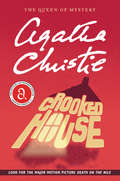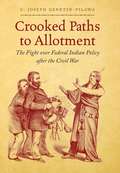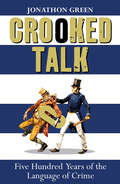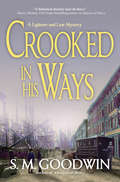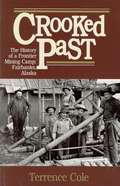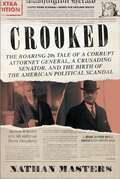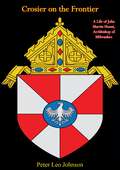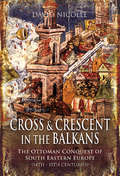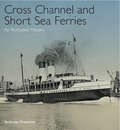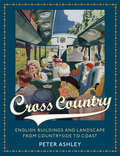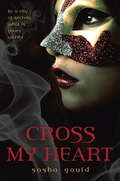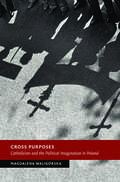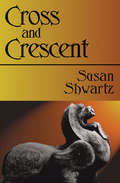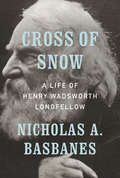- Table View
- List View
Crooked House: B2 (Collins English Readers Ser. #Vol. 48)
by Agatha ChristieAgatha Christie is more than the most popular mystery writer of all time. In a career that spans over half a century, her name is synonymous with brilliant deception, ingenious puzzles, and the surprise denouement. By virtually inventing the modern mystery novel she has earned her title as the Queen of Crime. Curious? Then you're invited to read.
Crooked Paths to Allotment
by C. Joseph Genetin-PilawaStandard narratives of Native American history view the nineteenth century in terms of steadily declining Indigenous sovereignty, from removal of southeastern tribes to the 1887 General Allotment Act. In Crooked Paths to Allotment, C. Joseph Genetin-Pilawa complicates these narratives, focusing on political moments when viable alternatives to federal assimilation policies arose. In these moments, Native American reformers and their white allies challenged coercive practices and offered visions for policies that might have allowed Indigenous nations to adapt at their own pace and on their own terms. Examining the contests over Indian policy from Reconstruction through the Gilded Age, Genetin-Pilawa reveals the contingent state of American settler colonialism. Genetin-Pilawa focuses on reformers and activists, including Tonawanda Seneca Ely S. Parker and Council Fire editor Thomas A. Bland, whose contributions to Indian policy debates have heretofore been underappreciated. He reveals how these men and their allies opposed such policies as forced land allotment, the elimination of traditional cultural practices, mandatory boarding school education for Indian youth, and compulsory participation in the market economy. Although the mainstream supporters of assimilation successfully repressed these efforts, the ideas and policy frameworks they espoused established a tradition of dissent against disruptive colonial governance.
Crooked Politics in Northwest Indiana
by Jerry DavichDefined by a tangled web of deception for more than a century, Northwest Indiana's political culture involved secret handshakes, tapped phone calls, backroom deals and murder. Found submerged in his car with a rock on the gas pedal, city official Babe Lopez's execution-style murder rocked East Chicago. Shot and killed at a political fundraiser, power broker Jay Given's murder occurred while four hundred guests mingled in a neighboring room. Former Lake Station mayor Keith Soderquist stole thousands of dollars from his reelection campaign and the city's food pantry account to gamble at local casinos. Author Jerry Davich explores the hidden political scandals and highly publicized court cases of public servants once sworn to serve and protect.
Crooked River
by Shelley PearsallThe year is 1812. A white trapper is murdered. And a young Chippewa Indian stands accused. Captured and shackled in leg irons and chains, Indian John awaits his trial in a settler’s loft. In a world of crude frontier justice where evidence is often overlooked in favor of vengeance, he struggles to make sense of the white man’s court. His young lawyer faces the wrath of a settlement hungry to see the Indian hang. And 13-year-old Rebecca Carver, terrified by the captive Indian right in her home, must decide for herself what—and who—is right. At stake is a life. Inspired by a true story,Crooked Rivertakes a probing look at prejudice and early American justice. From the Hardcover edition.
Crooked Snake: The Life and Crimes of Albert Lepard
by Lovejoy BotelerIn 1968, during Albert Lepard’s fifth escape from a life sentence at Parchman Penitentiary, he kidnapped Lovejoy Boteler, then eighteen years old, from his family’s farm in Grenada, Mississippi. Three decades later, still beset by half-buried memories of that time, Boteler began researching his kidnapper’s nefarious, sordid life to discover how and why this terrifying abduction occurred.Crooked Snake: The Life and Crimes of Albert Lepard is the true story of Lepard, sentenced to life in Parchman for the murder of seventy-four-year-old Mary Young in 1959. During the course of his sentence, Lepard escaped from prison six times in fourteen years. In Crooked Snake, Boteler pieces together the story of this cold-blooded murderer's life using both historical records and personal interviews—over seventy in all—with ex-convicts who gravitated to and ran with Lepard, the family members who fed and sheltered the fugitive during his escapes, the law officers who hunted him, and the regular folks who were victimized in his terrible wake.Throughout Crooked Snake, Boteler reveals his kidnapper’s hardscrabble childhood and tracks his whereabouts before his incarceration and during his jailbreaks. Lepard’s escapes take him to Florida, Michigan, Kansas, California, and Mexico. Crooked Snake captures a slice of history and a landscape that is fast disappearing. These vignettes describe Mississippi’s countryside and spirit, ranging from sharecropper family gatherings in Attala County’s Seneasha Valley to the twenty-thousand-acre Parchman farm and its borderlands teeming with alligator, panther, bear, and wild boar.
Crooked Talk: Five Hundred Years of the Language of Crime
by Jonathon GreenThe language of crime has a long and venerable history - in fact, the first collection of words specifically used by criminals, Hye-Way to the Spittel House, dates from as early as 1531. Jonathon Green is our national expert on slang, and in Crooked Talk he looks at five hundred years of crooks and conmen - from the hedge-creepers and counterfeit cranks of the sixteenth century to the blaggers and burners of the twenty-first - as well as the swag, the hideouts, the getaway vehicles and the 'tools of the trade'. Not to mention a substantial detour into the world of prisons that faced those unlucky enough to be caught by the boys in blue. If you have ever wondered when the police were first referred to as pigs, why prison guards became known as redraws, or what precisely the subtle art of dipology involves, then this book has all the answers.
Crooked in His Ways: A Lightner and Law Mystery (A LIGHTNER AND LAW MYSTERY #2)
by S. M. GoodwinPerfect for fans of C. S. Harris and Will Thomas, the murder of a wealthy financier unleashes a torrent of deadly secrets in pre-Civil War New York society in S. M. Goodwin's second book in the Lightner and Law mysteries.Albert Beauchamp disappeared just before Christmas in 1856. When he reappears more than a year later, he's in several pieces, packed in salt in a shipping crate in New Orleans. NYC inspectors Jasper Lightner and his partner, Hieronymus Law, are called in to investigate--but the further they dig into the wealthy financier's background, the dirtier the story gets. On the surface, Beauchamp had a lot of friends. But, as they discover, each had a good reason to hate him.Beauchamp's last will and testament--stashed away in a safety deposit box, along with a king's ransom in jewels--yields few clues, but Jasper and Hy discover something even more valuable: a little black book filled with names, dates, and a cache of damning details. Following a trail of leads that reaches back to the early 1840s, the detectives uncover a sordid litany of high society scandals that still threatens the city's moneyed establishment. And the shadowy figure who knows their dirtiest secrets re-emerges with a devious new plan that goes far beyond simple blackmail. The dark shadows grow longer as Jasper and Hy close in on the truth--and a killer lies in wait for his ultimate prey.
Crooked past: Fairbanks, Alaska
by Terrence ColeAn early history of Fairbanks Alaska and the scandle surrounding its founder.
Crooked, but Never Common: The Films of Preston Sturges
by Stuart KlawansIn a burst of creativity unmatched in Hollywood history, Preston Sturges directed a string of all-time classic comedies from 1939 through 1948—The Great McGinty, The Lady Eve, Sullivan’s Travels, The Palm Beach Story, and The Miracle of Morgan’s Creek among them—all from screenplays he alone had written. Cynical and sophisticated, romantic and sexually frank, crazily breakneck and endlessly witty, his movies continue to influence filmmakers and remain popular to this day. Yet despite this acclaim, Sturges’s achievements remain underappreciated: he is too often categorized as a dialogue writer and plot engineer more than a director, or belittled as an irresponsible spinner of laughs.In Crooked, but Never Common, Stuart Klawans combines a critic’s insight and a fan’s enthusiasm to offer deeper ways to think about and enjoy Sturges’s work. He provides an in-depth appreciation of all ten of the writer-director’s major movies, presenting Sturges as a filmmaker whose work balanced slapstick and social critique, American and European traditions, and cynicism and affection for his characters. Tugging at loose threads—discontinuities, puzzles, and allusions that have dangled in plain sight—and putting the films into a broader cultural context, Klawans reveals structures, motives, and meanings underlying the uproarious pleasures of Sturges’s movies. In this new light, Sturges emerges at last as one of the truly great filmmakers—and funnier than ever.
Crooked: The Roaring '20s Tale of a Corrupt Attorney General, a Crusading Senator, and the Birth of the American Political Scandal
by Nathan MastersThe riveting, forgotten narrative of the most corrupt attorney general in American history and the maverick senator who stopped at nothing to take him down Many tales from the Jazz Age reek of crime and corruption. But perhaps the era&’s greatest political fiasco—one that resulted in a nationwide scandal, a public reckoning at the Department of Justice, the rise of J. Edgar Hoover, and an Oscar-winning film—has long been lost to the annals of history. In Crooked, Nathan Masters restores this story of murderers, con artists, secret lovers, spies, bootleggers, and corrupt politicians to its full, page-turning glory. Newly elected to the Senate on a promise to root out corruption, Burton "Boxcar Burt" Wheeler sets his sights on ousting Attorney General Harry Daugherty, puppet-master behind President Harding&’s unlikely rise to power. Daugherty is famous for doing whatever it takes to keep his boss in power, and his cozy relations with bootleggers and other scofflaws have long spawned rumors of impropriety. But when his constant companion and trusted fixer, Jess Smith, is found dead of a gunshot wound in the apartment the two men share, Daugherty is suddenly thrust into the spotlight, exposing the rot consuming the Harding administration to a shocked public. Determined to uncover the truth in the ensuing investigation, Wheeler takes the prosecutorial reins and subpoenas a rogue&’s gallery of witnesses—convicted felons, shady detectives, disgraced officials—to expose the attorney general&’s treachery and solve the riddle of Jess Smith&’s suspicious death. With the muckraking senator hot on his trail, Daugherty turns to his greatest weapon, the nascent Federal Bureau of Investigation, whose eager second-in-command, J. Edgar Hoover, sees opportunity amidst the chaos. Packed with political intrigue, salacious scandal, and no shortage of lessons for our modern era of political discord, Nathan Masters&’ thrilling historical narrative shows how this intricate web of inconceivable crookedness set the stage for the next century of American political scandals.
Crookston
by Kristina M. GrayCrookston was first settled in 1872, organized in 1876, and incorporated in 1879. By 1880, the enterprising young town known as the "Queen City of the Northwest" had 1,500 inhabitants. Its location on the Red Lake River and in the fertile Red River Valley secured its tenure as the Polk County seat. Crookston first served the northwest as a trading center, then as a grain shipping point, a lumbering center with large sawmills, a brewery and liquor distribution base, and a railroad hub with terminal facilities, a roundhouse, and office headquarters. It was also a banking center of the prospering northwest. By 1915, Crookston's population of over 8,000 people made it the 14th-most-populated city in Minnesota.
Crosby, Stills, Nash and Young: The Wild, Definitive Saga of Rock's Greatest Supergroup
by David Browne"In what is the most comprehensive biography of the group to date, Browne compiles a fun and fast-paced music history.... an authoritative chronicle." --Publishers WeeklyThe first and most complete narrative biography of Crosby, Stills, Nash and Young, by acclaimed music journalist and Rolling Stone senior writer David Browne Even in the larger-than-life world of rock and roll, it was hard to imagine four more different men. David Crosby, the opinionated hippie guru. Stephen Stills, the perpetually driven musician. Graham Nash, the tactful pop craftsman. Neil Young, the creatively restless loner. But together, few groups were as in sync with their times as Crosby, Stills, Nash and Young. Starting with the original trio's landmark 1969 debut album, the group embodied much about its era: communal musicmaking, protest songs that took on the establishment and Richard Nixon, and liberal attitudes toward partners and lifestyles. Their group or individual songs--"Wooden Ships," "Suite: Judy Blue Eyes," "After the Gold Rush," "For What It's Worth" (with Stills and Young's Buffalo Springfield), "Love the One You're With," "Long Time Gone," "Just a Song Before I Go," "Southern Cross"--became the soundtrack of a generation. But their story would rarely be as harmonious as their legendary and influential vocal blend. In the years that followed, these four volatile men would continually break up, reunite, and disband again--all against a backdrop of social and musical change, recurring disagreements and jealousies, and self-destructive tendencies that threatened to cripple them both as a group and as individuals. In Crosby, Stills, Nash and Young: The Wild, Definitive Saga of Rock's Greatest Supergroup, longtime music journalist and Rolling Stone writer David Browne presents the ultimate deep dive into rock and roll's most musical and turbulent brotherhood on the occasion of its 50th anniversary. Featuring exclusive interviews with David Crosby and Graham Nash along with band members, colleagues, fellow superstars, former managers, employees, and lovers-and with access to unreleased music and documents--Browne takes readers backstage and onstage, into the musicians' homes, recording studios, and psyches, to chronicle the creative and psychological ties that have bound these men together--and sometimes torn them apart. This is the sweeping story of rock's longest-running, most dysfunctional, yet pre-eminent musical family, delivered with the epic feel their story rightly deserves.
Crosier on the Frontier: A Life of John Martin Henni, Archbishop of Milwaukee
by Peter Leo JohnsonCrosier on the Frontier, which was first published in 1959, is a fascinating biography on John Martin Henni (1805-1881), the Swiss-born prelate of the Roman Catholic Church who served as the first Archbishop of the Archdiocese of Milwaukee, Wisconsin from 1843 until his death in 1881.“FOR THE MORE than fifty years John Martin Henni labored as a priest in Ohio and as a bishop and archbishop in Wisconsin, he was inspired by a vision and guided by a practical foresight not given to many men of his or any other generation. Perhaps no one of his time exerted more consistent influence for good over so many people with such lasting results. Like another St. Paul, he was tireless in his journeys, fearless in his defense of the truth, and a bulwark against which the error and bigotry of his day could not prevail. It is time that his life is presented to our generation and to generations yet to come. His is too noble a figure to be lost in the haze of half remembered, easily forgotten fragments of unrecorded lore.”—William E. Cousins, Foreword
Cross & Crescent in the Balkans: The Ottoman Conquest of Southeastern Europe (14th–15th centuries)
by David NicolleThis is NOT just another retelling of the Fall of Constantinople, though it does include a very fine account of that momentous event. It is the history of a quite extraordinary century, one which began when a tiny of force of Ottoman Turkish warriors was invited by the Christian Byzantine Emperor to cross the Dardanelles from Asia into Europe to assist him in one of the civil wars which were tearing the fast-declining Byzantine Empire apart.One hundred and eight years later the Byzantine capital of Constantinople fell to what was by then a hugely powerful and expanding empire of the Islamic Ottoman Turks, whose rulers came to see themselves as the natural and legitimate heirs of their Byzantine and indeed Roman predecessors. The book sets the scene, explains the background and tells the story, both military, political, cultural and personal, of the winners and the losers, plus those 'outsiders' who were increasingly being drawn into the dramatic story of the rise of the Ottoman Empire.
Cross Bronx: A Writing Life
by Peter QuinnIn his inimitable prose, master storyteller Peter Quinn chronicles his odyssey from the Irish Catholic precincts of the Bronx to the arena of big-league politics and corporate hardball.Cross Bronx is Peter Quinn’s one-of-a-kind account of his adventures as ad man, archivist, teacher, Wall Street messenger, court officer, political speechwriter, corporate scribe, and award-winning novelist. Like Pete Hamill, Quinn is a New Yorker through and through. His evolution from a childhood in a now-vanished Bronx, to his exploits in the halls of Albany and swish corporate offices, to then walking away from it all, is evocative and entertaining and enlightening from first page to last. Cross Bronx is bursting with witty, captivating stories.Quinn is best known for his novels (all recently reissued by Fordham University Press under its New York ReLit imprint), most notably his American Book Award–winning novel Banished Children of Eve. Colum McCann has summed up Quinn’s trilogy of historical detective novels as “generous and agile and profound.” Quinn has now seized the time and inspiration afforded by “the strange interlude of the pandemic” to give his up-close-and-personal accounts of working as a speechwriter in political backrooms and corporate boardrooms:“In a moment of upended expectations and fear-prone uncertainty, the tolling of John Donne’s bells becomes perhaps not as faint as it once seemed. Before judgment is pronounced and sentence carried out, I want my chance to speak from the dock. Let no man write my epitaph. In the end, this is the best I could do.” (from the Prologue)From 1979 to 1985 Quinn worked as chief speechwriter for New York Governors Hugh Carey and Mario Cuomo, helping craft Cuomo’s landmark speech at the 1984 Democratic Convention and his address on religion and politics at Notre Dame University. Quinn then joined Time Inc. as chief speechwriter and retired as corporate editorial director for Time Warner at the end of 2007. As eyewitness and participant, he survived elections, mega-mergers, and urban ruin. In Cross Bronx he provides his insider’s view of high-powered politics and high-stakes corporate intrigue.Incapable of writing a dull sentence, the award-winning author grabs our attention and keeps us enthralled from start to finish. Never have his skills as a storyteller been on better display than in this revealing, gripping memoir.
Cross Channel and Short Sea Ferries: An Illustrated History
by Ambrose GreenwayThis new book, beautifully illustrated with a magnificent collection of over 300 photographs, covers the development of a much-loved type of vessel, the 'classic' cross channel or short sea passenger ferry often described as a liner in miniature. From the mid–19th century paddle ferries slowly evolved into screw-driven steamers but it was the advent of the steam turbine and the construction of the railway steamers The Queen and Brighton in 1903 that caught the attention of the world. Similarly-propelled ships multiplied and their use soon spread to the Antipodes, Japan, the Mediterranean and North America. In 1912 Rudolf Diesel's new oil engine went to sea in a cargo ship but it was not until 1925 that it was first employed to widespread acclaim in the Danish North Sea packet Parkeston. In 1934 it made its debut on the English Channel with the Belgian Government's striking 25-knot motor ferry Prins Baudouin. The inexorable increase in car travel from the 1930s led to the development of a new breed of specialised car ferry accessed through bow and stern doors and the proliferation of these after WW2 led to the eventual demise of the 'classic' passenger ferry in the 1960s.With its informative introductory texts and abundant photographs and detailed captions, this book will appeal to ship enthusiasts around the world and to all those who mourn the passing of the golden age of the passenger ship.
Cross Country
by Peter AshleyIn Cross Country photographer and author Peter Ashley unleashes his passion for Blighty. He takes us on an enlightening jaunt that encompasses many of England's most loved regions. His love of buildings and landscape extends far beyond architecture in picturesque surroundings. By combining personal reminiscence and an ear for intriguing anecdote, he shows us with wit, and sometimes irreverent comment, just how richly varied the fabric of England is: abandoned Cornish tin mines above tide-washed caves; Norfolk boat sheds leaning on salt marches; Romney Marsh shepherd's houses disappearing behind roadside willows; and hedges looked over in Wiltshire. Local details are found in both Essex estuaries and Cumbrian sand dunes; and long abandoned railway lines are once again pressed into service to take us around his beloved High Leicestershire. Ashley never misses the curious and neglected - be it a sheep wash in the Cotswolds or a disused petrol pump in Herefordshire. He travels deep into t eh countryside he cares about. His wry observations allow us to rediscover and delight in what many of us might previously have deemed familiar territory.
Cross Currents
by John ShorsThailand's pristine Ko Phi Phi island attracts tourists from around the world. There, struggling to make ends meet, small-resort owners Lek and Sarai are happy to give an American named Patch room and board in exchange for his help. But when Patch's brother, Ryan, arrives, accompanied by his girlfriend, Brooke, Lek learns that Patch is running from the law, and his presence puts Lek's family at risk. Meanwhile, Brooke begins to doubt her love for Ryan while her feelings for Patch blossom. In a landscape where nature's bounty seems endless, these two families are swept up in an approaching cataclysm that will require all their strength of heart and soul to survive. . . .
Cross My Heart
by Sasha GouldVenice, 1585.When 16-year-old Laura della Scala learns that her older sister, Beatrice, has drowned, she is given no time to grieve. Instead, Laura's father removes her from the convent where he forcibly sent her years earlier and orders her to marry Beatrice's fiancé, a repulsive old merchant named Vincenzo. Panicked, Laura betrays a powerful man to earn her way into the Segreta, a shadowy society of women who deal in only one currency--secrets. The Segreta seems like the answer to Laura's prayers. The day after she joins their ranks, Vincenzo is publicly humiliated and conveniently exiled. Soon, however, Laura begins to suspect that her sister's death was not a tragic accident but a cold-blooded murder--one that might involve the Segreta and the women she has come to trust.From the Hardcover edition.
Cross Purposes: Catholicism and the Political Imagination in Poland (New Studies in European History)
by Magdalena WaligórskaNo other symbol is as omnipresent in Poland as the cross. This multilayered and contradictory icon features prominently in public spaces and state institutions. It is anchored in the country's visual history, inspires protest culture, and dominates urban and rural landscapes. The cross recalls Poland's historic struggles for independence and anti-Communist dissent, but it also encapsulates the country's current position in Europe as a self-avowed bulwark of Christianity and a champion of conservative values. It is both a national symbol – defining the boundaries of Polishness in opposition to a changing constellation of the country's Others – and a key object of contestation in the creative arts and political culture. Despite its long history, the cross has never been systematically studied as a political symbol in its capacity to mobilize for action and solidify power structures. Cross Purposes is the first cultural history of the cross in modern Poland, deconstructing this key symbol and exploring how it has been deployed in different political battles.
Cross and Crescent
by Susan ShwartzThe center of the greatest empire in the world, the seat of Christianity, Byzantium is a revered city. Marked by gargantuan monuments to God and peopled by the most royal of princes, and the most affluent citizens, Byzantium cannot possibly ever fall. Now under siege by Islam, the Byzantine Empire must look to Christians from the West for help in winning back Jerusalem, the most hallowed of cities. The Byzantines must prevent the disintegration of their empire while protecting the faith of many, but at what expense?
Cross and Scepter: The Rise of the Scandinavian Kingdoms from the Vikings to the Reformation
by Sverre BaggeA concise history of medieval ScandinaviaChristianity and European-style monarchy—the cross and the scepter—were introduced to Scandinavia in the tenth century, a development that was to have profound implications for all of Europe. Cross and Scepter is a concise history of the Scandinavian kingdoms from the age of the Vikings to the Reformation, written by Scandinavia's leading medieval historian. Sverre Bagge shows how the rise of the three kingdoms not only changed the face of Scandinavia, but also helped make the territorial state the standard political unit in Western Europe. He describes Scandinavia’s momentous conversion to Christianity and the creation of church and monarchy there, and traces how these events transformed Scandinavian law and justice, military and administrative organization, social structure, political culture, and the division of power among the king, aristocracy, and common people. Bagge sheds important new light on the reception of Christianity and European learning in Scandinavia, and on Scandinavian history writing, philosophy, political thought, and courtly culture. He looks at the reception of European impulses and their adaptation to Scandinavian conditions, and examines the relationship of the three kingdoms to each other and the rest of Europe, paying special attention to the inter-Scandinavian unions and their consequences for the concept of government and the division of power.Cross and Scepter provides an essential introduction to Scandinavian medieval history for scholars and general readers alike, offering vital new insights into state formation and cultural change in Europe.
Cross of Fire: A Pirate Devlin Novel
by Mark KeatingThe pirate Olivier Levasseur, 'the Buzzard', has captured the greatest ship ever to sail the high seas, the Virgin of the Cape, a Portuguese ship carring a solid gold cross seven feet long. The Fiery Cross of Goa. Levasseur is hiding somewhere in the Indian Ocean, but Patrick Devlin is on his tail. However, Devlin's former master, and bitter enemy, John Coxon, has been sent to kill him . . .CROSS OF FIRE sees Devlin traverse Guinea and the slave coasts of Africa and the pirate islands of the Seychelles with the Royal Navy blocking his path, his old pirate enemies hunting him and his murderous former master hot on his heels.
Cross of Fire: A Pirate Devlin Novel
by Mark KeatingThe pirate Olivier Levasseur, 'the Buzzard', has captured the greatest ship ever to sail the high seas, the Virgin of the Cape, a Portuguese ship carring a solid gold cross seven feet long. The Fiery Cross of Goa. Levasseur is hiding somewhere in the Indian Ocean, but Patrick Devlin is on his tail. However, Devlin's former master, and bitter enemy, John Coxon, has been sent to kill him . . .CROSS OF FIRE sees Devlin traverse Guinea and the slave coasts of Africa and the pirate islands of the Seychelles with the Royal Navy blocking his path, his old pirate enemies hunting him and his murderous former master hot on his heels.
Cross of Snow: A Life of Henry Wadsworth Longfellow
by Nicholas A. BasbanesA major literary biography of America's best-loved nineteenth-century poet, the first in more than fifty years, and a much-needed reassessment for the twenty-first century of a writer whose stature and celebrity were unparalleled in his time, whose work helped to explain America's new world not only to Americans but to Europe and beyond. From the author of On Paper ("Buoyant"--The New Yorker; "Essential"--Publishers Weekly), Patience and Fortitude ("A wonderful hymn"--Simon Winchester), and A Gentle Madness ("A jewel"--David McCullough).In Cross of Snow, the result of more than twelve years of research, including access to never-before-examined letters, diaries, journals, notes, Nicholas Basbanes reveals the life, the times, the work--the soul--of the man who shaped the literature of a new nation with his countless poems, sonnets, stories, essays, translations, and whose renown was so wide-reaching that his deep friendships included Charles Dickens, Nathaniel Hawthorne, Ralph Waldo Emerson, Julia Ward Howe, and Oscar Wilde.Basbanes writes of the shaping of Longfellow's character, his huge body of work that included translations of numerous foreign works, among them, the first rendering into a complete edition by an American of Dante's Divine Comedy. We see Longfellow's two marriages, both happy and contented, each cut short by tragedy. His first to Mary Storer Potter that ended in the aftermath of a miscarriage, leaving Longfellow devastated. His second marriage to the brilliant Boston socialite--Fanny Appleton, after a three-year pursuit by Longfellow (his "fiery crucible," he called it), and his emergence as a literary force and a man of letters.A portrait of a bold artist, experimenter of poetic form and an innovative translator--the human being that he was, the times in which he lived, the people whose lives he touched, his monumental work and its place in his America and ours.
